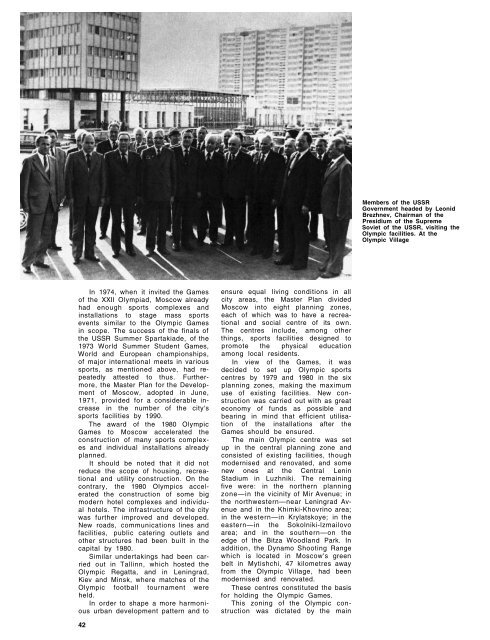or1980v2pt1
or1980v2pt1
or1980v2pt1
Create successful ePaper yourself
Turn your PDF publications into a flip-book with our unique Google optimized e-Paper software.
In 1974, when it invited the Games<br />
of the XXII Olympiad, Moscow already<br />
had enough sports complexes and<br />
installations to stage mass sports<br />
events similar to the Olympic Games<br />
in scope. The success of the finals of<br />
the USSR Summer Spartakiade, of the<br />
1973 World Summer Student Games,<br />
World and European championships,<br />
of major international meets in various<br />
sports, as mentioned above, had repeatedly<br />
attested to thus. Furthermore,<br />
the Master Plan for the Development<br />
of Moscow, adopted in June,<br />
1971, provided for a considerable increase<br />
in the number of the city's<br />
sports facilities by 1990.<br />
The award of the 1980 Olympic<br />
Games to Moscow accelerated the<br />
construction of many sports complexes<br />
and individual installations already<br />
planned.<br />
It should be noted that it did not<br />
reduce the scope of housing, recreational<br />
and utility construction. On the<br />
contrary, the 1980 Olympics accelerated<br />
the construction of some big<br />
modern hotel complexes and individual<br />
hotels. The infrastructure of the city<br />
was further improved and developed.<br />
New roads, communications lines and<br />
facilities, public catering outlets and<br />
other structures had been built in the<br />
capital by 1980.<br />
Similar undertakings had been carried<br />
out in Tallinn, which hosted the<br />
Olympic Regatta, and in Leningrad,<br />
Kiev and Minsk, where matches of the<br />
Olympic football tournament were<br />
held.<br />
In order to shape a more harmonious<br />
urban development pattern and to<br />
42<br />
ensure equal living conditions in all<br />
city areas, the Master Plan divided<br />
Moscow into eight planning zones,<br />
each of which was to have a recreational<br />
and social centre of its own.<br />
The centres include, among other<br />
things, sports facilities designed to<br />
promote the physical education<br />
among local residents.<br />
In view of the Games, it was<br />
decided to set up Olympic sports<br />
centres by 1979 and 1980 in the six<br />
planning zones, making the maximum<br />
use of existing facilities. New construction<br />
was carried out with as great<br />
economy of funds as possible and<br />
bearing in mind that efficient utilisation<br />
of the installations after the<br />
Games should be ensured.<br />
The main Olympic centre was set<br />
up in the central planning zone and<br />
consisted of existing facilities, though<br />
modernised and renovated, and some<br />
new ones at the Central Lenin<br />
Stadium in Luzhniki. The remaining<br />
five were: in the northern planning<br />
zone—in the vicinity of Mir Avenue; in<br />
the northwestern—near Leningrad Avenue<br />
and in the Khimki-Khovrino area;<br />
in the western—in Krylatskoye; in the<br />
eastern—in the Sokolniki-lzmailovo<br />
area; and in the southern—on the<br />
edge of the Bitza Woodland Park. In<br />
addition, the Dynamo Shooting Range<br />
which is located in Moscow's green<br />
belt in Mytishchi, 47 kilometres away<br />
from the Olympic Village, had been<br />
modernised and renovated.<br />
These centres constituted the basis<br />
for holding the Olympic Games.<br />
This zoning of the Olympic construction<br />
was dictated by the main<br />
Members of the USSR<br />
Government headed by Leonid<br />
Brezhnev, Chairman of the<br />
Presidium of the Supreme<br />
Soviet of the USSR, visiting the<br />
Olympic facilities. At the<br />
Olympic Village


